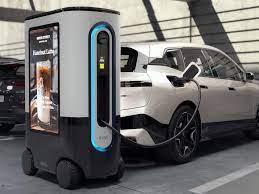Automakers, utilities and cleantech companies are giving old batteries new life in ESSs, mobile charging stations and more.
Electric vehicle (EV) batteries have an expiration date, but just because they can’t power your car anymore doesn’t mean they have to power down for good. Second-life batteries are an emerging business opportunity and potential boon for renewable energy adoption.
Old EV batteries can be repurposed for many useful applications that have less demanding power requirements than EVs. Many recent projects involving automakers, utilities and energy management companies suggest that this approach may soon become the norm.
A second life off the grid
Second-life battery applications can be grouped into three main categories: off-grid stationary applications, on-grid stationary applications and mobile applications.
Off-grid stationary applications, also known as independent energy storage systems (ESSs), provide power to isolated systems that are not connected to the primary electrical grid. Battery energy storage systems are a prime use case for second-life batteries.
Energy storage systems could be beneficial to many industries. They could replace diesel generators in remote applications and provide flexibility to industrial users with high energy demands. ESSs are convenient in the energy arbitrage business of buying and storing electricity during off-peak periods and selling it during peaks.
Renewable energy sources can also benefit from using second-life batteries for storage, as ESSs can eliminate the intermittence of renewable energy sources such as wind and solar. Residential and commercial customers are a huge market for second-life batteries, as they can replace existing generator systems by storing and selling surplus energy.
It is important to analyze the risks of using second-life EV batteries for ESSs. The majority of EV batteries use lithium ion technology, well-known for its fire risk in the event of improper handling. The higher the required power, the higher the risk. From that point of view, second-life EV batteries may be more viable for small-scale applications.
Second-life EV batteries for the grid
ESSs can also be effective for on-grid applications, as they provide both technical and economic benefits for electric utilities. With ESSs, utilities can postpone building new power plants and transmission infrastructure, and reduce purchasing energy from third parties when demand exceeds capacity.
Second-life batteries are also promising as part of frequency regulation systems for the power grid. It is essential to keep the grid’s voltage, power and frequency stable prevent damaging equipment and infrastructure. In particular, frequency must be kept within strictly defined limits—typically below one percent—as imposed by regulators such as the Federal Energy Regulation Committee (FERC) in the U.S.
Frequency deviation is caused by differences in energy generation and consumption requirements. When the grid frequency drops, protective relays automatically initiate load shedding to restore system frequency.
Power plants usually maintain constant generation to ensure system stability. Generators have high inertia and cannot quickly adapt to a changing grid load, which is a challenge for traditional frequency regulation. This means that the energy needs to be absorbed somewhere when demand is reduced (downward regulation) and when demand increases, the regulation system must provide energy quickly (upward regulation).
Second-life batteries could be used alongside gas turbine generators to provide quick energy to the grid. Though this is a promising application, so far there is scant data on its viability.
EV batteries charging EV batteries
Charging stations are a key factor in EV deployment. More EVs on the street requires more EV infrastructure, and second-life EV batteries are a natural fit for EV charging stations.
Battery-powered EV charging stations do not require a permanent connection to the grid, and can be powered by renewable energy sources such as solar panels. So-called mobile charging stations are designed for simple and quick deployment at any location, which is particularly advantageous for distant or isolated areas. Mobile chargers have the potential to strengthen the existing charging infrastructure system.
Mobile charging stations can be taken a step further. Some companies are developing fully autonomous EV charging robots that can top off a battery tank with no human intervention. EV Safe Charge’s Ziggy charging robot, for example, helps EV drivers find parking spaces and then charges their car.
Second-life EV batteries around the world
Many are interested in the promise of second-life batteries, from governments and utilities to investors and manufacturers of batteries and EVs. The latter will be a key player in the second-life battery business, and many EV manufacturers have been considering the concept as a business opportunity and an important step in the circular economy.
For example, Volvo experimented with second-life EV batteries in a 2021 collaboration with Nordic energy producer Fortum and Swedish energy management solution provider Comsys. The companies used 48 out-of-service EV batteries from Volvo hybrid vehicles for a 250kWh energy storage system at Fortum’s Landafors hydropower plant on the Ljusnan river in Sweden.
“Volvo Cars has big ambitions with regards to the circular economy and we are putting great effort in finding new business models that enable us to maximize battery usage over the course of their entire life cycle. This project is in line with those objectives and will offer us new insight about the batteries’ lifespan and how they can be used outside of our cars,” said Susanne Hägglund, head of Volvo’s car service business, in a Fortum press release.
In Japan, automaker Nissan is part of a joint venture called 4R Energy that determines the next step for expired EV batteries (the four R’s stand for recycle, refabricate, reuse and resell). The company determines the best secondary application for every battery based on a letter grade—A-grade batteries may be fit for new EVs, B-grade batteries for industrial machinery or energy storage, and C-grade for backup power units, for example. According to Nissan, these batteries have a second-life span of 10 to 15 years.
French automaker Renault has contributed depleted batteries from its Kangoo Z.E. electric vans to a second life in E-STOR frequency response systems, built for grid operators by U.K. firm Connected Energy. Elsewhere in Europe, German automakers BMW and Audi have each also engaged in partnerships to give a second life to their EV batteries.
Though the use cases for second-life batteries are still being proven, their promise is undeniable. Not only do they promote more sustainable design, they provide novel opportunities for automotive companies, grid operators, energy storage providers, EV charging companies, property owners, investors and—most importantly—engineers.
Read the original article by Edis Osmanbasic for www.engineering.com here.



